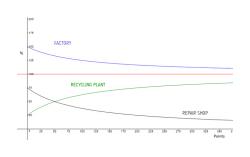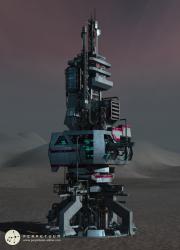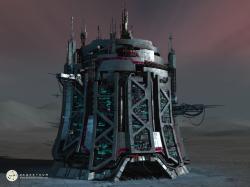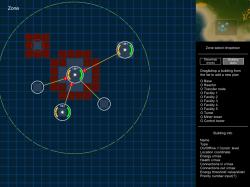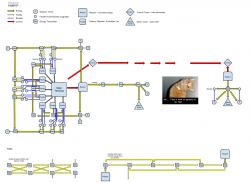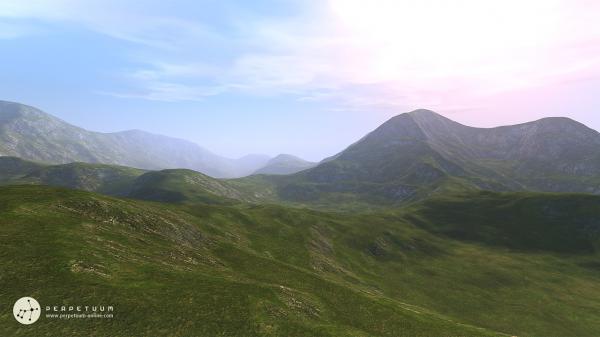The end of the year is near and we’d like to offer you some insight on what’s going on around Perpetuum, tell you about what’s currently in development, and get you a glimpse of what the near future will bring. Be warned, it’s a long read, but I didn’t want to miss anything - and I’m sure you’ll have many questions even so.
Behind the scenes
We know we’ve been a bit quiet lately, and this has its reasons. In the past months much of our development power has been put into things that are not directly related to the game itself.
For one, we’re of course getting ready to release Perpetuum on Steam. This involves a lot of paperwork, preparing marketing materials, and not to forget about getting the game itself fit for releasing it to such a broad audience.
Steam Greenlight - a highly public event - happened during the autumn, however we've been spending most of our time since the Gamma Expansion working on getting Perpetuum the extra funding it needs so we can take a quality leap forward in terms of world content. We realize that to create the type of content that would allow Perpetuum to grow to the next level requires a team much larger than ours, and all of us are working very hard on making that possible. This process involves all of the devs to some extent, and is mostly why we've been so quiet during these last months. These things however take time, and the new year will see us continuing the effort.
Meanwhile we’re working on the game itself as well of course, so in the rest of this blog I’m going to talk about what’s coming up. The time for small changes is over, we’re getting the big guns now.
As we stated after the gamma expansion, we’d like to focus on the PvE part of the game for a while, since that part is in desperate need of some fresh blood.
We’ve chosen three large systems currently in the game, the ones where we feel that reworking them would substantially make the game more fun to play: the kernel research system and the knowledgebase, the assignment system, and the new player experience with emphasis on the tutorials.
So let’s see them one by one in detail. The ideas presented here are still work in progress and may change as we work out the smaller details, and of course we will consider your feedback as well.
Research revamp
What’s wrong with the current system?
- Random research results are not fun. This is especially true when a technology line in your knowledgebase is close to complete, at which point kernel research becomes vastly irritating. Due to the randomness the system doesn’t allow for any serious planning or strategy.
- There are too many types of kernels. Kernels have been partly intended as a second income besides plasma, but their sheer number fragments the kernel market and has a negative effect on their trading potential.
- Corporations are not a part of the system at all. They are forced to feed one or two of their agents with kernels to stay competitive. This is very risky, as losing those agents leaves the corporation with close to no prototyping capability.
- Research has much more potential. Why waste it simply on prototyping, a feature used by not many players?
The new system:
- Point-based. Instead of getting technology directly from kernels, you consume kernels to gather research points (RP). You then spend these points in the knowledgebase for specific item technologies.
- Choose your research goals. No more random results - you choose what you want to spend your RP on, using a fixed technology tree. It’s completely plannable, research only what you really need. I’m sure you’ve seen such a tree in many games already - just imagine a branch with many expanding nodes, starting out at the base from the lowest tier technology, and unlocking your way up to the most coveted items.
- Reduce the number of kernels to 6 main types. They all hold a different type of RP, which accumulate into separate pools. To help keeping the system calculable, kernels will always contain a fixed amount of RPs. To keep scalability, NPCs will drop not just one of these, but many, depending on their ranks.
- The RP technology types are: nuimqol, pelistal, thelodica, common (used for industrial too), hi-tech and “new-tech”. Unlocking item technologies in the knowledgebase will use a varying mix of these RP types, depending on the item’s faction, tier, or even novelty. (Nasty details: the latter is what “new-tech” will be used for, and we’ll always use it when we introduce new robots or modules into the game. When the time comes where “new” items become “old”, and we’re ready to introduce a new batch of technology, accumulated “new-tech” points and kernels will always be converted down to hi-tech points and kernels - this is to prevent unlocking new technology on the first day by prior RP accumulation.)
- Separate knowledgebase for individual agents and agent-independent knowledgebases for corporations. Agents always accumulate RP to their own knowledgebase, but they will have the option to donate any amount of unspent RP to their corporation at any time. The corporation-level knowledgebase can then be researched using the donated points by anyone with the necessary access.
- Having an item researched in an agent’s own knowledgebase will unlock prototyping option for it (like it is currently), and having an item researched in a corporation’s knowledgebase will allow every member with proper access to prototype that item.
- Here’s the twist: having the same item researched in your own knowledgebase AND in the knowledgebase of your corporation as well will provide a factory production bonus for you. We think this provides an incentive to develop both knowledgebases, your own and your corporation’s as well.
So what will happen to your current knowledgebase when this gets into the game? Well it will be wiped of course and you’ll have to start over, ha-ha. Nah, I’m just kidding, once we figure the exact RP value of every item in the new technology tree, we can give you the matching amount of RP for your actual knowledge, so you can basically rebuild your knowledgebase from scratch. Now, we can’t guarantee that you’ll have the same amount of “raw research value” after that, but I’m sure that being able to select specific technologies to research will mostly provide you with a better result overall. We still have to figure out what happens to unresearched kernels, so we’ll get back to that.
Some of you have been also wondering what happened to the promised new tier of items using colixum. Well, this happened :) We didn’t want to build upon a broken system and create an even bigger chaos. This new system will allow us to introduce new item technology in a much cleaner and nicer way, and that’s what we’ll do once it’s ready.
A new assignment system
I’ll be honest with you: the current assignment system is something we put into the game almost 3 years ago just to have an assignment system. There wasn’t much concept behind it, and it shows - it’s bland, grindy, and not really fun.
At first the main problem is that the player is presented with a huge list of available assignments. This can be quite overwhelming and you just don’t know what to do. Later on you figure out which assignments are the easiest to do or give you the most rewards, and then you’ll grind those over and over, effectively destroying your own game experience. And then we introduce the 6/10 rule - insult to injury.
So we’ve been planning a complete revamp of the system for a while now, and unlike in the case of research, randomness could be our friend here. This is a huge undertaking, and luckily we can separate it down into two stages: the first stage will use the current assignments, but will change the way they are provided and accepted, and the second stage will change the assignments themselves.
When you open the assignments window in the new system, you won’t see a list of specific assignments, only some buttons for types of assignments - combat, industrial, transport, and so on. These will be arranged into a grid, where rows mean assignment levels and columns mean assignment types.
Once you click a button in this grid, you’ll be assigned a random assignment of the selected type and level. Then you can either complete that given assignment, or you can choose to abort it, in which case you’ll be given a penalty. However, that penalty is not a deduction of relation points like now, rather a penalty multiplier for your next assignment’s reward. This means that the more assignments you abort in a row, the less rewards you will get for the assignment which you finally complete. The penalty will be cleared after a certain time or when you complete an assignment.
So this random assignment provider would be the first stage. The second stage is where we also randomize the objectives within the assignments. This system is still heavily under development, but it would use assignment templates, where we only set the number and types of objectives that you have to do. The exact NPCs you have to destroy, or the minerals you have to mine, or the items you have to transport would be randomly selected from a pool of objectives around a certain radius of the location where you take the assignment. This would maximize objective variety and minimize boring walking time. In the new system we also plan to scatter small assignment terminals around the islands, so you will be able to take them there too and not just in the big bases.
Assignments in squads
I'm sure most of you are familiar with the current mechanic for doing assignments cooperatively in squads, which is far from being optimal or useful.
As it stands today, the members of the squad and the assignment they are doing have a very loose connection. Everyone is doing their own assignment, it's not shared among members. One member's objectives are not completed if another member does them. The only actual mechanic is that you can share the money and relation reward among your squad members if you chose to do so when accepting the assignment.
We had a little poll on the forum where I asked you which of the two new squad mechanics you would prefer. While the result turned out not really decisive, it turns out that in a system where assignments are given randomly, only the first option makes sense, because there is very little chance that the squad members can get the same assignment.
So we’ll stick with option number 1, where every member of the squad is working on a common goal and contributes to one shared assignment, the squad leader’s one.
Instances
I left this for last because frankly this is the topic where I can share the least details - it’s very much work in progress. However I wanted to tell you as early as possible that instances are coming.
Before you pick up those torches and pitchforks and yell that instances have no place in an open sandbox world, I’d like to explain why they are needed, and what for.
What we definitely don’t want is to drain population from the open world into an infinite number of hidden pockets - the islands feel empty even so, we don’t want to make it even worse.
However there are a number of features and mechanics where we just simply can’t go around instances without having a negative impact on gameplay experience. In an open world you can’t set up a preset game event without pitfalls, however carefully you plan and script it. There are so many unknown variables that a single speck of dust can break the machine.
This is especially critical for a new player - when he can’t finish a tutorial objective because someone mined out all the titan ore before him, he will rarely ask for help, and probably leaves for something else. That’s why first and foremost we’ll use instances for our tutorials, where we can be (almost) sure what happens to the player, and where we'll have much more options than in the open world. Think for example temporarily giving a heavy mech to a new player just to give him a taste what the future holds for him, or to let him try various factions before he makes his actual choice.
Of course it would be a waste of technology to use instances only for a tutorial. It holds many possibilities, like small dungeons that you can scan down and enter from the open world to clear out, or controlled PvP arenas with proper limits, teams, timers and everything.
Closing
That’s pretty much all I have for you right now. These are the features that we’ll be working on in the next 2-3 months, to give you a rough timeframe. Of course once we’re ready with one system we’ll patch it out, you won’t have to wait for all that time.
And don’t worry if all of this is a bit hard to grasp now, I’ll post a follow-up to this blog a bit later when we already have some GUI-mockups and stuff.
Post your opinions and questions below, or feel free to create separate feature discussions on the forums, and last but not least, we wish a Happy New Year to all of you!

